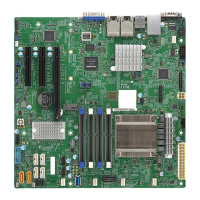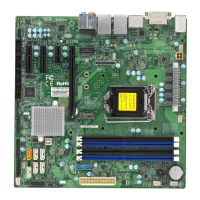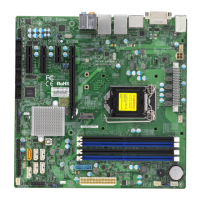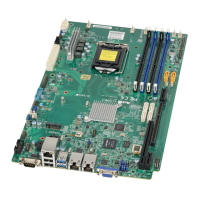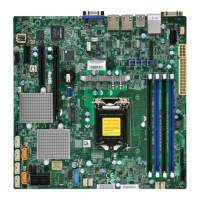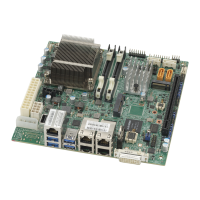Do you have a question about the Supermicro X11SSH-F and is the answer not in the manual?
Details the Super X11SSH-F/-LN4F motherboard's specifications and features, including CPU, memory, and chipset.
Details the comprehensive features of the motherboard, including CPU, memory, expansion slots, and I/O.
Provides essential information on power supply requirements and connection for system stability.
Details precautions and procedures for handling static-sensitive devices to prevent damage.
Guides on how to install the motherboard into the chassis, including tools and mounting hole locations.
Provides step-by-step instructions for installing the CPU and CPU heatsink.
Explains memory support, population configurations, and the process for installing DIMM modules.
Provides systematic procedures for troubleshooting common system issues like no power or no video.
Details numerous advanced BIOS settings for CPU, chipset, power management, and PCI-Express.
Configures system boot options, including boot mode selection and boot device priorities.
Provides critical safety warnings regarding battery replacement and disposal to prevent explosion risks.
Explains the UEFI BIOS flash chip structure and the process for recovering a corrupted BIOS image.
Details the steps to recover the BIOS using a USB-attached device and the necessary file format.
Provides step-by-step instructions for rebooting the system using the JBR1 jumper for BIOS recovery.
Details the Super X11SSH-F/-LN4F motherboard's specifications and features, including CPU, memory, and chipset.
Details the comprehensive features of the motherboard, including CPU, memory, expansion slots, and I/O.
Provides essential information on power supply requirements and connection for system stability.
Details precautions and procedures for handling static-sensitive devices to prevent damage.
Guides on how to install the motherboard into the chassis, including tools and mounting hole locations.
Provides step-by-step instructions for installing the CPU and CPU heatsink.
Explains memory support, population configurations, and the process for installing DIMM modules.
Provides systematic procedures for troubleshooting common system issues like no power or no video.
Details numerous advanced BIOS settings for CPU, chipset, power management, and PCI-Express.
Configures system boot options, including boot mode selection and boot device priorities.
Provides critical safety warnings regarding battery replacement and disposal to prevent explosion risks.
Explains the UEFI BIOS flash chip structure and the process for recovering a corrupted BIOS image.
Details the steps to recover the BIOS using a USB-attached device and the necessary file format.
Provides step-by-step instructions for rebooting the system using the JBR1 jumper for BIOS recovery.
| IPMI LAN (RJ-45) port | Yes |
|---|---|
| USB 2.0 ports quantity | USB 2.0 ports have a data transmission speed of 480 Mbps, and are backwards compatible with USB 1.1 ports. You can connect all kinds of peripheral devices to them. |
| USB 3.2 Gen 1 (3.1 Gen 1) Type-A ports quantity | 2 |
| Maximum UDIMM memory | 64 GB |
| Number of DIMM slots | 4 |
| Supported DIMM module capacities | 4GB, 8GB, 16GB |
| Memory voltage | 1.2 V |
| Supported memory types | DDR4-SDRAM |
| Supported memory clock speeds | 1600, 1866, 2133 MHz |
| BIOS type | AMI |
| ACPI version | 4.0 |
| BIOS memory size | 16 Mbit |
| RAID levels | 0, 1, 5, 10 |
| Supported storage drive interfaces | SATA III |
| On-board graphics card model | Aspeed AST2400 |
| Processor socket | LGA 1151 (Socket H4) |
| Intel Xeon series | E3-1200 |
| Processor manufacturer | Intel |
| Processor thermal power (max) | 80 W |
| Wi-Fi | No |
| Ethernet interface type | Gigabit Ethernet |
| Number of SATA III connectors | 8 |
| Trusted Platform Module (TPM) version | 1.2 |
| Motherboard chipset | Intel® C236 |
| Motherboard form factor | micro ATX |
| Width | 224 mm |
|---|


